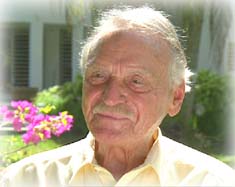|
|
Para ver este documento
en español, oprima aquí.
Puerto Rico Profile: Luis A. Ferre
January 28, 2000
Copyright © 2000 THE PUERTO RICO HERALD. All Rights Reserved.
 In his 96 years, Luis
A. Ferre -- successful businessman, art patron, and former Governor
of Puerto Rico -- has had a unique opportunity to witness, and
influence, a period of dramatic change on his native island. In his 96 years, Luis
A. Ferre -- successful businessman, art patron, and former Governor
of Puerto Rico -- has had a unique opportunity to witness, and
influence, a period of dramatic change on his native island.
Ferre was born in Ponce in 1904, soon after the transition
of Puerto Rico from Spanish to American control. It was a time
of great promise, and many Puerto Ricans believed they would soon
enjoy the rights which they had been denied for so long. Ferre's
father, a Cuban immigrant and the founder of the Puerto Rico Iron
Works, described to his young son how, in 1898, the people of
Ponce had welcomed U.S. troops landing on the island.
The arrival of American forces did not, however, bring the
immediate advantages that some had predicted. Instead, the process
of political, economic, and cultural growth in Puerto Rico which
began in 1898 has lasted all of Luis Ferre's life.
In 1917, when Ferre was 13 years old, the Puerto Rican people
were granted U.S. citizenship. "Of course I can't remember
it distinctly," he said 75 years later, "but ever since,
I've been very proud of that day. I feel it is a great privilege
and a great honor to be a citizen of the greatest republic that
we've had in the history of the world."
Ferre's respect for the United States dates back to his years
as a university student in Cambridge, Massachusetts. That period
away from home was formative, both professionally and politically.
He recalled much later: "I was a part of the old Hispanic
community, but then I went to the mainland to study, in Boston
at M.I.T., and I became completely sold on the importance of having
Puerto Rico become a state of the Union, on an equal basis with
the rest of the states."
Ferre returned to Puerto Rico with a degree in engineering
and a firm belief in statehood. He built his father's business
into a hugely successful industrial enterprise, becoming a millionaire
in the process. As his fortune grew, so did the movement among
Puerto Ricans to govern themselves.
Luis Ferre entered politics at a propitious time in the island's
history. In 1948, Puerto Ricans elected a governor for the first
time, choosing Luis Muñoz Marín. In 1952 the
year before commonwealth status and internal self-government,
Luis Ferre was elected to the Puerto Rican House of Representatives.
From this position, he advocated commonwealth as a stepping stone
to his ultimate goal of statehood for Puerto Rico.
Ferre saw the chance to further the cause in 1967, the year
of the first political status plebiscite on the island. While
commonwealth was the winning option, Ferre utilized the plebiscite
to mobilize statehood forces and establish a new political entity,
the New Progressive Party (NPP).
Ferre ran for Governor of Puerto Rico as the NPP candidate
in 1968, and he won a close race. His victory marked the end of
25 years of political dominance by Muñoz Marín's
Popular Democratic Party (PDP), and the beginning of a new era
in which the NPP and PDP would vie for the support of the Puerto
Rican people.
Ferre was Governor for one term, from 1969 to 1973. However,
his importance stems not so much from what he achieved in those
four years, as from the precedent that he set. After him came
more statehooders like Carlos Romero Barceló, Hernan Padilla,
and Pedro Rosselló. First under Ferre's guidance, then
under his inspiration, the New Progressive Party with its
statehood agenda has become a legitimate and powerful political
force. As he noted in 1997, "when I became Governor of Puerto
Rico, as a statehood governor, we had 400,000 votes. Today, we
won the election in 1996 with 1,600,000 votes."
Along with his political astuteness and business savvy, Ferre
is also a great lover and supporter of the arts. "Art is
something that enriches all nations," Ferre said in 1997.
"It is very important to teach [art to] children when they're
young because it opens up their minds and imagination and keeps
them alive. In accordance with this philosophy, he founded the
Museo de Arte de Ponce in 1965. The museum features artwork from
medieval times to the present, focusing on the relevance of European
in Puerto Rico. Housed in an impressive, modern building, it is
a major cultural attraction in Ferre's home city
Over the past century, Puerto Rico has grown in freedom, wealth,
and influence. Similarly, Luis Ferre has attained the honored
positions of elder statesman and philanthropist. He is one of
four Puerto Ricans to have received the Presidential Medal of
Freedom. (Muñoz Marín, Antonia Pantoja, and Gov.
Ferre's sister, Isolina, are the other three.) Reflecting on this
distinction, he said, "I honestly believe that this was a
recognition by the people of the United States to the people of
Puerto Rico. After all, the people of Puerto Rico for the last
eighty years [since attaining citizenship] have been contributing,
in many ways, to the enrichment and the growth of our country."
|

